As it happens, I was sent another crossover SUV to evaluate this week. And as it happens, this one’s also different in a number of respects from the others like it – including the Toyota RAV4 I wrote about last week.
Including how it looks.
The Mazda CX-30 is also a little smaller than the RAV – as well as the Honda CR-V and Nissan Rogue. But only a little.
And it’s also a lot less expensive. It isn’t the one to take off-road; the RAV4 TRD is the one for that.
But it is the one that rules the road – because it offers the most powerful engine you can get in small crossover that isn’t a really small one, like the Hyundai Kona.
Which comes standard with a much less powerful engine.

What It Is
The CX-30 is Mazda’s compact-sized crossover, with two rows of seats, seating for five and available all-wheel-drive. But that is not what makes it different from other, slightly larger crossovers such as the Toyota RAV4 (reviewed here), Honda CR-V and Nissan Rogue.
The big difference is you can get the CX-30 with a 250 horsepower turbocharged engine. Models like the RAV4, CR-V and Rogue don’t offer much more than 200 horsepower – if they offer that much.
Another, less tangible, thing that Mazda offers is different (dare it be said, sexy) styling – though it comes at the cost of cargo capacity, of which it has less than more practicality-minded small crossovers like the CR-V, RAV4 and Rogue. 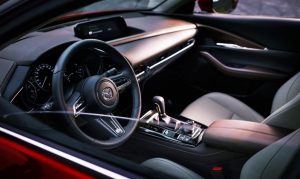
Prices start at $22,950 for the base S trim with FWD. A a top of the line Premium Plus with AWD and the 250 horsepower turbo’d engine stickers for $35,400.
Which brings up another big difference between the Mazda and its slightly larger rivals.
That being its much lower cost.
A RAV4 stickers for $27,575 to start; the CR-V’s base price is $26,800 and the Rogue stickers $27,360 to start. 
So why does the CX-30 cost so many thousands less than those others? It’s because the RAV4, CR-V and Rogue are all slightly larger. They are now verging on mid-sized, while the CX-30 is compact sized.
But the CX-30 is still close enough in size to be cross-shopped, especially if you prefer to not spending several thousand dollars more to get a little bit more size. And if you need something a little larger – that also offers a 250 horsepower turbocharged engine – there’s the Mazda CX-5.
Another possible cross-shop is the $21,990-to-start Hyundai Kona. But it is smaller than the CX-30 and it comes standard with a much less powerful (and smaller) engine. It ism however, available with the strongest engine in the class.
What’s New for 2023
The standard (non-turbocharged) 2.5 liter engine gets a 5 horsepower bump (to 191) and a slight gas mileage bump. Second row side-impact air bags are also standard on all trims.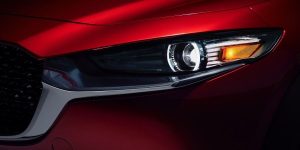
What’s Good
One of the most affordable small crossovers on the market.
One of the most stylish small crossovers on the market.
One of the most powerful small crossovers on the market.
What’s Not So Good
It’s smaller than most other crossovers.
It’s got less room – for cargo – than slightly larger crossovers.
High-powered turbo engine only available in most expensive trims.
This little Mazda offers two engines. Or rather, two versions of one engine.
All CX-30s come standard with a 2.5 liter four cylinder engine. The standard version – which isn’t turbocharged – makes 191 horsepower and that’s already more standard horsepower than all-you-can-get in slightly larger crossovers like the Honda CR-V, which comes only with a 1.5 liter four (with a turbo) and 190 horsepower. Even the RAV4 – which used to be available with a powerful V6 – now comes only with a 203 horsepower four (also 2.5 liters, also without a turbo).
But it’s the little CX’s optional engine – or version of it – that really stands out. It’s the same size (2.5) liters and type (an inline four) but with a turbo boosting its output to 250 horsepower and 320 ft.-lbs. of torque – much more power (and torque) than you can get in slightly larger crossovers, like the RAV4, CR-V, Rogue and others.
Accordingly, it can get to 60 in a very speedy 5.7 seconds – about two seconds quicker than the RAV4, CR-V and Rogue.
It also goes almost as far on a gallon of gas – 22 city, 30 highway – as the standard (non-turbo’d) version goes, which is 26 city, 33 highway. You exchange 3-4 MPG for almost 60 more horsepower, which isn’t a bad trade-off.
The standard 2.5 liter engine (without the turbo) also goes a little farther on a gallon than the slightly-less-powerful version (186 hp) of that engine in last year’s CX-30 went, which was 24 city, 31 highway. That’s a gain of about 2 MPG – and a gain of 5 horsepower, which isn’t a trade-off at all.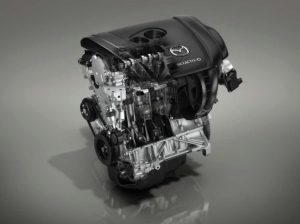
Another no-downside aspect of the Mazda vs. many of the others (though not the RAV) is that its standard automatic transmission isn’t a CVT (continuously variable) transmission. It’s a six speed automatic that shifts up and down rather varying through the ranges. The latter can be a slight fuel-efficiency advantage, in that the CVT is always in or very close to the right range and doesn’t have to shift up – or down – to get there. But it’s a small one (viz, the Honda CR-V, which does come with a CVT, is only slightly more fuel-efficient – 28 city, 34 highway) and a common trade-off is more drivetrain noise, because the CVT tends to keep the engine operating at higher RPM when you’re accelerating, especially if the engine hasn’t got a lot power to offer – whereas a geared automatic will shift up, lowering the RPM (and thus, the noise).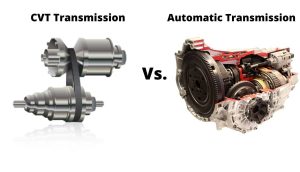
Also, CVTs are – as a general thing – not as long-term reliable as conventional (geared) automatics, chiefly because of the inevitable metal-fatiguing of the band/belt that expands/contracts to continuously vary the range you happen to be in as you’re driving.
The Mazda’s automatic comes close to matching the efficiency of a CVT – without being a CVT. It does so, chiefly, by having a really deep (0.599) sixth (overdrive) gear, which greatly reduces engine RPM during steady-state cruising.
Like other crossovers in the class – including the slightly larger ones, like the RAV4, CR-V and Rogue – the CX-30 is front-wheel-drive as it comes and is available with all-wheel-drive. The AWD system features standard torque-vectoring, which means power is metered side to side as well as front to back, so as to enhance both handling and traction.
This little Mazda can also pull a small (1,500 lb.) trailer.
Hyundai’s Kona isn’t rated to pull anything. And its standard 2.0 liter four only makes 147 horsepower. It’s also paired with a CVT. However, you can get the Kona with the strongest engine in the class – a 2.0 liter four boosted to 286 hp – paired with a dual-clutch automatic.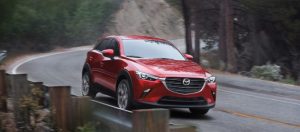
On The Road
Crossovers are fundamentally about practicality. Otherwise why would you want to buy one?
The idea is to fit more into less – people as well as cargo – vs. a sedan of about the same size that you might otherwise want to buy.
Crossovers, which ride higher than sedans, are also better be able to get out of your driveway – and to work – when there’s snow. That’s why they ride higher off the ground – and are taller than sedans. And have liftgates in the back rather than a trunk.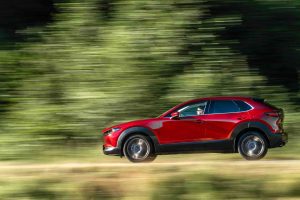
But that doesn’t mean they can’t also be fun, at least a little bit.
Mazda puts more effort in here than most. This isn’t surprising given Mazda also makes the Miata, which is arguably the best mass-market sports car ever made. Maybe even the best, period. This is relevant for the same reason that sons often take after fathers; blood tells.
Of course, the “blood” here is more like attitude, which is reflected in the general eagerness of Mazda vehicles in general to be as much like the Miata as they can be. Echoing the Miata, the CX’s suspension tuning invites pushing it a little. The steering feel has just the right weight to it. Everything syncopated and focused not on the getting-there so much as having a little fun getting there.
Most of all, this includes getting there fast.
The CX’s available turbocharged engine is stronger than the Miata’s and that evens things up a lot, even though the CX weighs a lot more than its lightweight, two-seater sibling. It blows the liftgates off the RAV4, CR-V and Rogue, at any rate. And – in spite of the Kona N’s significant horsepower advantage – the larger Mazda is only slightly less quick. The Kona N getting to 60 in 5.3 seconds (vs. 5.7 or the Mazda).
What both of these crossovers need – in terms of making them more fun – would be a manual transmission. But that’s been sidelined by the need to comply with various government edicts that are easier to comply with when you can program a transmission to shift in such as a way as to score best on the tests. You can’t do that with a manual – and that’s why it’s hard to find manuals in new cars.
That said, the Mazda’s six speed automatic doesn’t have too many gears (just six) and so it does not have to shift down – and back up – as often. And it doesn’t have the lurchy low-speed feel that you sometimes get with dual-clutch automatics, as in the Kona N.
At The Curb
When Mazda brought out the CX-30 as a new model back in 2020, it was meant to be just a little bit bigger than the subcompact CX-3 but just a little bit smaller than the mid-sized CX-5 (which is about the same size as the RAV4, CR-V and Rogue). But it was such a little bit bigger – than the CX-3 – that it was hard to tell the difference between the two and Mazda ended up dropping the CX-3 after the 2021 model year, leaving the CX-30 to serve as its just a little-bit-smaller-than-the-CX-5 small crossover.
It is also just a little smaller than most of the really popular small (but slightly larger) crossovers like the RAV4, CR-V and Rogue. But not so much smaller that it doesn’t cross-shop well against them – especially if you don’t need a little bit larger.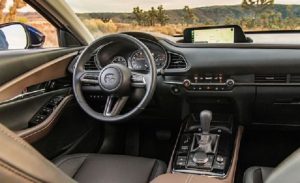
Especially in view of how much less it costs.
Front and rear seat legroom in the CX-30 (41.7 inches and 36.3 inches, respectively) is very close to that offered by slightly larger models like the RAV (41 inches and 37.8 inches, respectively) with the major substantive difference being cargo space. The Mazda has 20.2 cubic feet behind its second row and 45.2 cubic feet with the back seats folded; slightly larger – slightly longer – models like the RAV have 37.6 cubic feet behind the second row and 69.8 cubic feet in total with those seats folded.
You may of course need the extra cargo room. But what this little Mazda offers is a lot more room for cargo than even a full-size sedan – and about the same room for people as slightly larger but much pricier small crossovers like the RAV, et al.
And it’s still a little bit larger than the very small Hyundai Kona, which is about the same size as the discontinued CX-3 but costs about the same while offering less than the CX-30 – especially as it comes, under the hood (just 147 horsepower, remember).
As far as looks:
This Mazda is a crossover but it tries hard to not remind you of that – by reminding you of the Miata. In the driver’s seat, it looks a lot like the Miata. The gauge cluster (analog-style tach and speedometer) is similar in layout and – if you forget about the back seats behind you – it’s not hard at all to let your mind wander and imagine yourself driving a Miata.
It’s not the same, of course. Obviously. But it’s just close enough to make driving a CX-30 because you need those back seats (and the extra room behind them) and for those reasons can’t drive a Miata right now a lot more pleasant.
The Rest
Two small nits to pick with this small Mazda.
The first is that while the available turbocharged engine is a powerhouse, it requires premium fuel to make its maximum-rated power. That, of course, means paying 20 cents (or more) per gallon extra every time you fill up, if you want to access its maximum-rated power.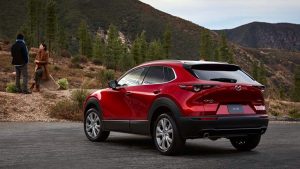
On the other hand, the Kona N’s powerhouse engine also requires premium to deliver its maximum horsepower – while the Mazda’s standard engine makes a lot more power (on regular) than the Kona’s standard engine.
The other thing is the CX-30’s input system for the secondary functions such as operating the stereo. It’s a two step process. First, select the function. Then adjust. It’s just a little more involved than a single process – such as a knob you can turn to change the station without first having to find the digital representation of a knob.
The Bottom Line
A little bit smaller can sometimes be just big enough.
. . .
Got a question about cars, Libertarian politics – or anything else? Click on the “ask Eric” link and send ’em in! Or email me at EPeters952@yahoo.com if the @!** “ask Eric” button doesn’t work!
If you like what you’ve found here please consider supporting EPautos.
We depend on you to keep the wheels turning!
Our donate button is here.
If you prefer not to use PayPal, our mailing address is:
EPautos
721 Hummingbird Lane SE
Copper Hill, VA 24079
PS: Get an EPautos magnet or sticker or coaster in return for a $20 or more one-time donation or a $10 or more monthly recurring donation. (Please be sure to tell us you want a magnet or sticker or coaster – and also, provide an address, so we know where to mail the thing!)
My eBook about car buying (new and used) is also available for your favorite price – free! Click here. If that fails, email me at EPeters952@yahoo.com and I will send you a copy directly!




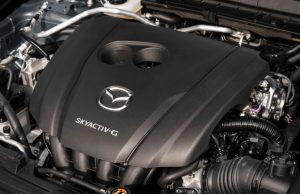







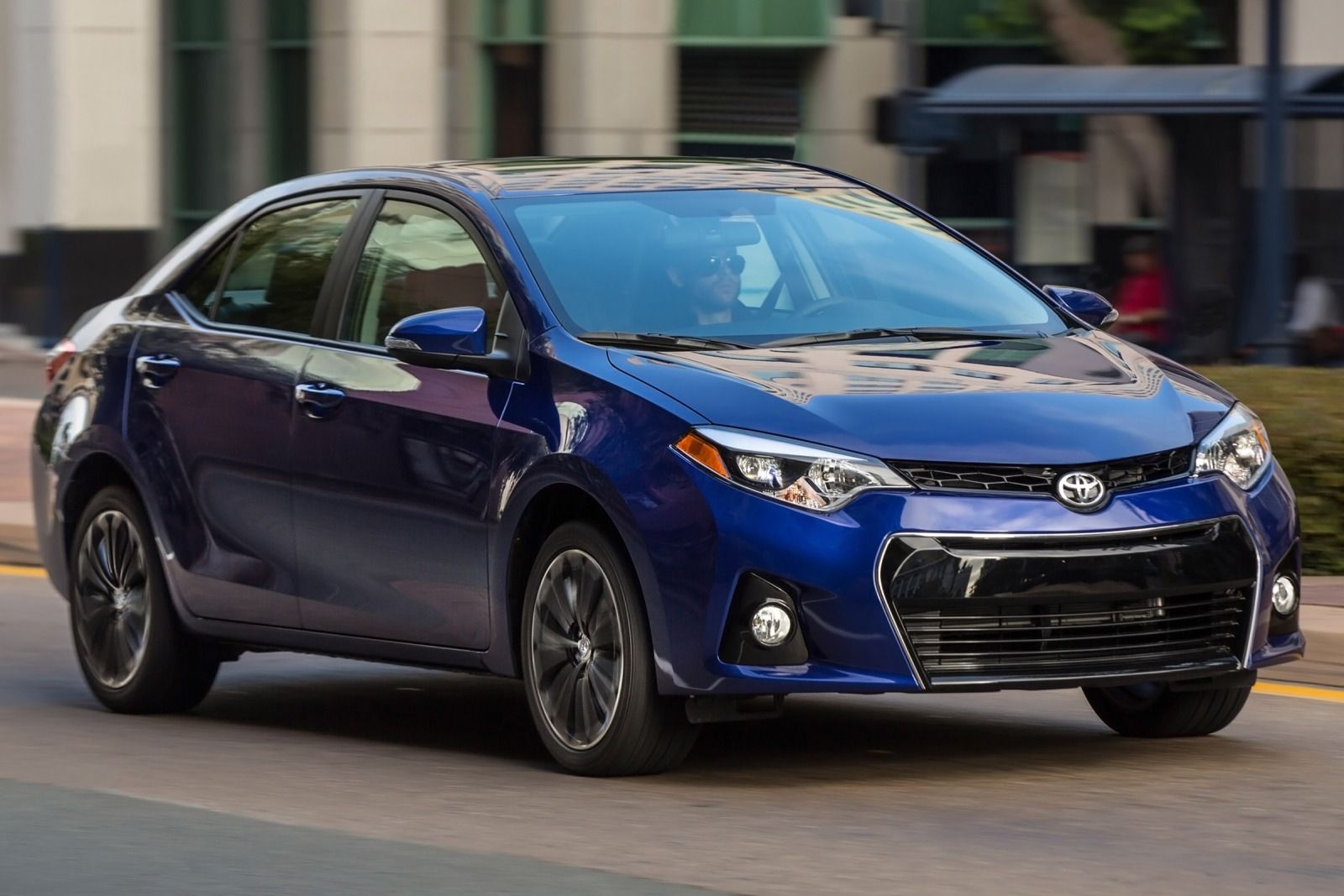
Eric,
I’m either getting this or an CX-50 next spring but I have a question that I can’t seem to track down the answer to. You only get extra horsepower with 93 octane gas, but here in Colorado they only do 91 octane. Any idea if that will still kick the horsepower up?
Hi Brass,
You should be fine; octane sold often varies with altitude; your “mile high” 91 octane premium is the functional equivalent of what they sell a lower altitude. I like both of these Mazdas. Heck, I like all of Mazda’s vehicles; they’ve got a pulse. Many others don’t!
Hey Eric, what do you think about the CX-50 and/or CX-9? After reading this article and talking with a friend, I think that I want to test drive a couple Mazda models before I sign up for a GV-70. I have a feeling that, while they are very nice, that I’ll still like the GV-70 better.
One thing that I noticed is that all of the vehicles that I’m considering: CX-50, CX-9, GV-70 (and maybe Volvo V90) all claim “3500lbs towing capacity.”
As you probably know the CX-50, CX-9 both have 2.5T i4. The highest trim levels of the Mazda models claims “256hp 320 trq”. The V90 comes with a 2.0T i4 and claims “295hp 310 trq”.
The GV-70 with the 2.5T i4 claims “300 hp”. While the 3.5T claims “375hp” and I can’t seem to find the torque specifications for either.
But all of the above say “3500lbs towing capacity”. Wouldn’t the GV-70 with the 3.5T have a greater towing capacity?
Also, with regard to the V90 i4. Seems as though 295hp is an awful lot to squeeze out of a 2.0T doesn’t it? Wouldn’t that lead to the engine wearing out a whole lot faster than any of the other models that I’m looking at?
Hi EM,
While I like all of these, the GV has a number of factors in its favor that may be relevant, chief among them that is it based on a rear-drive (rather than FWD) layout and for that reason handles like the rear-drive sport sedan it’s based upon. Rear-drive-based is also generally preferable for towing. Also, you can get the GV with a 3.5 V6, much larger (and much stronger) than the strongest available engines in the others…
Also, while there is less of an “amenities gap” nowadays between a luxury-brand vehicle such as the GV and brands such as Mazda, etc., there is still a difference in terms of overall feel, materials used and so on.
I really appreciate the feedback! I mean, I’ll take a look (because why not?) at the others but I’m pretty sure I’m down for the GV-70 with the 3.5T v6. From what I’m seeing, I might not even be able to test drive a CX-50. Mainly my wife wants to make sure that I’m sure that I’m sure about the GV-70. I did test drive one up in Annapolis and, so far, I love it!
After nearly 2 months (literally 1 week shy) of waiting for the parts from Audi, I finally got that A4 Allroad sunroof repaired just yesterday! I’m gonna auction it off on Doug DeMuro’s Cars & Bids (most likely). But I wanna get the replacement figure out and ordered first.
So if all goes well, I’ll test drive a couple others and likely get that my next car on order before the end of the year! 🤞
I’m waiting for the CX-50 to hit the market.
Today’s vehicles are money savers – I’m not buying any of them.
Why?
Auto stop/start, CVT, AFM, direct injection, 4-cylinder engines, turbochargers,
dual-clutch automatics, nagging “safety” reminders, computerized
everything, or a fiery house-burner (electric vehicle).
Recently, a Florida politician apparently had more than enough to drink – ran in to
a tree and the vehicle he was driving ratted him out – called 911. No injuries or
“victim” but not good for his career. Another of the conveniences of newer vehicles.
I agree, libertyx –
So much that is good, with much that is bad embedded. This Mazda can receive “over the air updates,” as many new cars are capable of receiving (and sending). No, thanks. I’ll be “clinging” to my disconnected vehicles forever.
As an old guy (72) I absolutely “feel your pain.” I just traded my ’17 Tacoma in for a Mazda CX-5 a couple of weeks ago. I was very leery about it for the same reasons you mentioned — the truck had zero nannies. I’ve had trucks since 1975 and retired last year so I didn’t really need one anymore (although I would have bought another Tacoma, but the wait was 6-8 months. Screw that). A couple of online buddies (my generation) had CX-5s and they really liked them.
I had several not-good experiences with the dealer (West Herr Mazda in Canandaigua, NY) the worst in the 54 years that I’ve been buying new vehicles, so I came out with a chip on my shoulder for the new car itself (it took 5 weeks from buying to delivery, not their fault but the fault of ours and all the world’s governments for going along with the Covid plandemic and plugging up the markets. Mine was on a ship in the Pacific when I bought it). But having had it for almost 3 weeks now, it’s starting to grow on me.
One nanny that was mildly annoying was the “going out of your lane” warning which vibrated the steering wheel slightly when being a bad boy. Good luck having a PDF manual: it is mostly (I would say 75%) italicized “warnings” about this and that stupid thing that any driver should already know. Yes it’s much easier searching for keywords than a hard copy, but otherwise mostly useless. Back in the day, nobody looked at owner’s manuals, which were only 30 or so pages long anyway instead of 4-500. I told the salesman when I picked it up that it was the first vehicle in my life that I bought and wasn’t really sure if I knew how to drive it home. Ok, old-guy rant over.
Thanks to a Mazda forum, I found that simply pressing a button on the passenger-jet looking dash disabled the lane warning, AND IT STAYS OFF even after restarting — unlike many vehicles which don’t do that. The radio/audio system controls are completely different from most anything else out there. It has a big screen, but not a touch screen. You control it with knobs and buttons on the console, right about where your hand rests anyway, which is actually more convenient than a touch screen once you get used to it.
I did not get the turbo; I have an ’07 Vette if I want to go fast and it’s not stressed with a turbo or SC. The Mazda has a normal 6-speed auto and actually handles surprisingly well around corners and is very driveable overall. I hope it handles as well (AWD) in the snow as my 4WD truck did, as I have an uphill driveway and one-foot or more snowfalls are not unusual here in the boonies of western NYS.
So far it’s okay and not as bad as I thought, but we’ll see.
Hi Bruce,
Glad you found the turn-off switch; Mazda is better than most in this regard, as you’ve discovered!
Yes Eric, I was shocked that it stayed off. It does display a small orange warning icon all the time in the tach telling me its off, but that’s easy to ignore.
Supposedly it does have cylinder deactivation, but I have never noticed anything strange while driving.
Of course all these nannies, whether active or not, makes the machine more complex with the possibility of more potential problems to arise as it ages.
Mazdas must be designed by folks that enjoy driving, I occasionally end up with the daughters ‘15 Mazda 6, it’s just a pleasure to tool around in. Nice steering, great brakes, decent styling inside and out, solid body. This is their third Mazda over 17 years all have been great cars. My 03 Ford Escape was a Mazda/Ford joint project and it shows in the body integrity and great handling even 20 years in, the “go cart” of SUVs.
I’d like to know more about turbo engine life if you stay on top of maintenance – I’m a stickler for using quality oil and filters hoping this would be rewarded with long life. Or, do they just go south early due to high internal load fatigue?
Great review!! $23K for 190HP is a good deal, but $34K for 250HP is just a stretch to far. But the torque difference between the turbo/nonturbo may make it worth it. I hope the warranty and quality is as good as the price, but if its actually made in Japan, probably so.
Thanks, Saxons!
I always enjoy seat time in Mazdas . . . all of them!
Sadly, I think all the American market CX-30’s are made in Mexico. Ever since I had a made in Japan 1999 Corolla, I’ve been pretty loyal to having a made in Japan car! Currently it’s a 2014 Mazda3. If I ever have to get another vehicle, it’ll probably be a made in Japan CX-5 just because it’ll be easier for an old, crippled guy to get in and out of.
As I noted above in my previous (lengthy post), when I bought my ’23 CX-5 the end of September, it was on a ship in the Pacific coming from Japan.